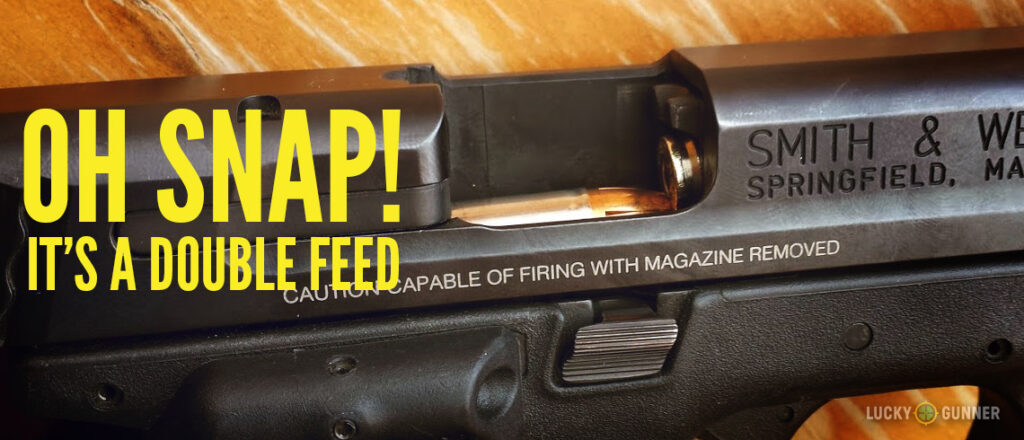On Monday, I talked about carrying spare magazines with your carry gun. The most common reason given for carrying extra ammo is because you never know how many rounds might be required to fend off an attacker. But that’s not the only reason. Semi-autos can run into issues with cycling, and in some cases, these malfunctions are difficult to recover from unless you have a spare magazine handy. Usually, this is due to the infamous double feed malfunction…
How to Clear a Double Feed Malfunction
Safety Note: In the video, I demonstrated the malfunction clearance both with snap cap dummy rounds as well as with live ammo. When setting up your pistol for double feed malfunction drills on the range with live ammo, use some kind of dummy rounds for the chambered cartridge. If none are available, just be careful to ease the slide forward on the live round so the primer in the chambered round isn’t struck with enough force to set it off. That would be bad.
Alternative Methods
My favored version of the malfunction clearance drill for a double feed is the Lock, Drop, Rack, Rack, Rack, Insert, Rack, Bang (or LDRx3IRB™ if you like catchy initials). At the end of the video, I mentioned a different method that can be done with a single magazine, in which you would just hold or stow the magazine you removed instead of letting it drop once the chamber is clear.
A third variation also omits the “lock” step of the drill. If you’re able to get a good grip on the base of the magazine, you can often rip it out by force while pressing the magazine release. Then you would rack to clear the chamber, re-insert the mag, and rack, bang as normal. These latter two versions of the malfunction clearance are a lot easier if the mags have large base pads, but it may still be possible with low profile mags if you can “claw” them out by the baseplate with your fingers or fingernails.
Efficiency vs. Speed
The clearance drill I used in the video is the version I believe to be most efficient, but not necessarily the fastest. That claim would go to the last technique I just mentioned. That is, assuming all goes according to plan. If you can’t get a good grip on the magazine when attempting to remove it, or you drop it while trying to rack the slide, then you could end up taking at least twice as long to recover. The LDRx3IRB™ is also a complex set of motions to attempt under stress, but I believe it’s much easier to accomplish because it eliminates the need to attempt to retain the original magazine.
Another down side to not using a spare magazine for the malfunction clearance is that sometimes the the magazine itself is the cause of the malfunction to begin with. If that’s the case, then reinserting the offending magazine means you might have to perform the drill all over again. Using a second magazine reduces this risk.
Plan B
Carrying a spare magazine just in case you run into a malfunction in a life threatening situation might be a diligent thing to do, but that should be plan B. When a pistol goes “click” instead of “bang”, most of the time a simple tap-rack will fix the problem. In terms of training time, I’d place priority on getting in some good practice with tap-rack-bang drills before becoming too preoccupied with the double-feed clearance. Both are good things to have in your tool box, but the basic tap-rack is easier to master and is a lot more likely to be needed.
Most of the time, however, well-maintained quality equipment will prevent the need for performing any kind of malfunction clearance. All guns have stoppages at one time or another, but you can drastically cut down on their frequency by sticking to the following guidelines:
- Keep your guns lubricated. Even if you don’t clean very often, lubricate your pistol regularly
- Replace magazines periodically, especially if they are loaded and unloaded frequently.
- Use quality self-defense ammo that’s been adequately function tested in your individual carry gun.
- Read your owner’s manual for your pistol and replace wear parts at recommended intervals.
- Avoid relying on budget-quality guns for self-defense. I won’t go into detail here on what qualifies as “budget-quality”, but look for that to be addressed in a future post.
If you use quality gear and take good care of it, then you should not be seeing many double feeds on the range. In fact, if I witnessed my carry gun experiencing a double feed more often than once every 1000 rounds or so without a clear cause that could be easily fixed (e.g., change ammo brands, replace extractor, etc), then I would probably carry something different. Quality guns and gear are more affordable now than they have ever been in the past. It’s wise to know how to quickly clear semi-auto malfunctions, but unless you’re on an extremely tight budget, there’s no good reason to carry a gun that is so failure prone that your chance of a double-feed in a self-defense situation is of any statistical significance. Depending on how strongly you believe in Murphy’s Law, you may choose to carry a spare magazine anyway, and that’s fine, but don’t give Murphy any extra help by carrying crappy or poorly maintained gear.

